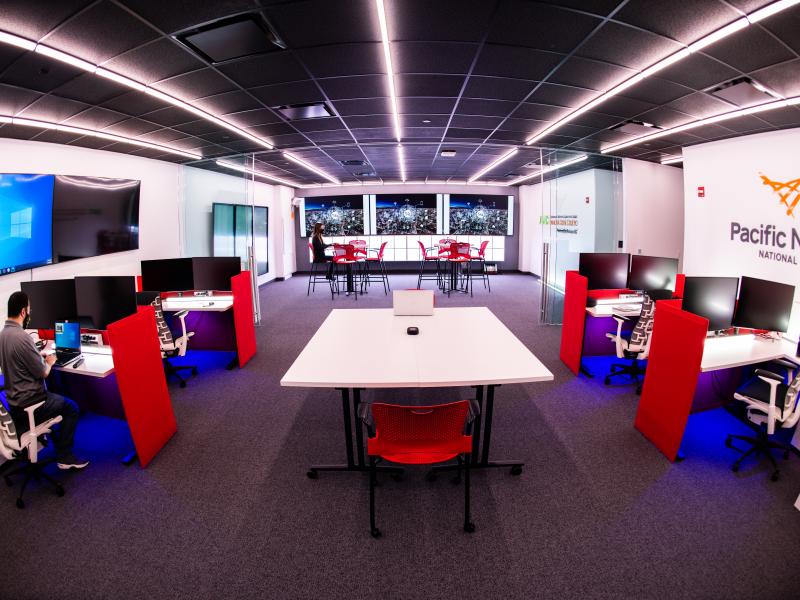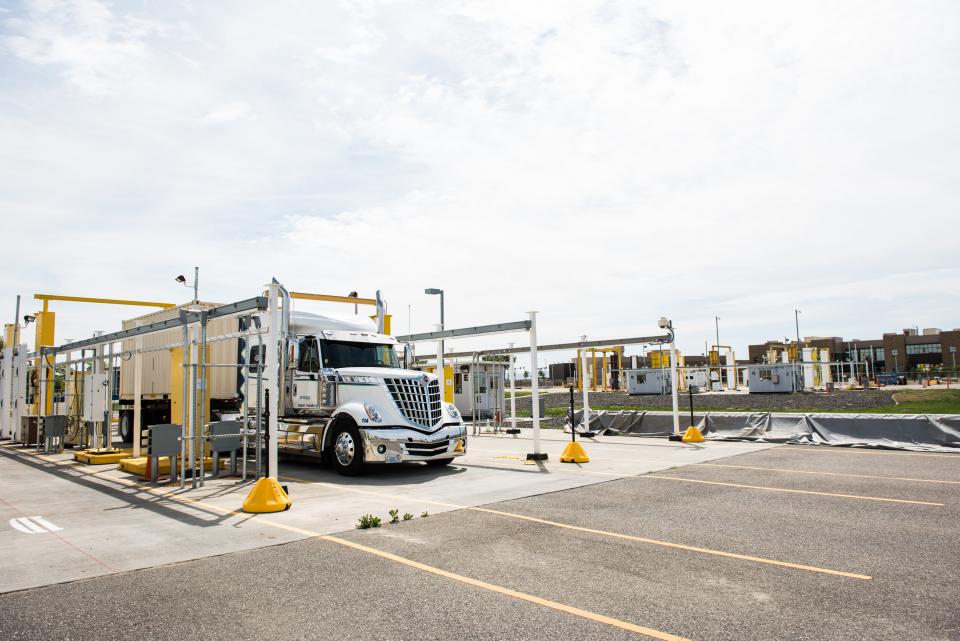A bomb disposal robot ventures into locations unsafe for humans to travel. It's a risky job where the correct move must be made every time. However, these robots cannot make complex decisions by themselves. Instead, a human operator located a safe distance from the site manipulates the controls.
Through a camera positioned on the robot, the operator sees through the robot's eyes. But the view is only 2D, which limits depth perception and view angles, and has led to robots getting stuck or even falling over. A 360-degree camera, combined with a virtual reality headset, could solve these problems.
"A 360-degree video stretches all around the viewer in every direction," said Annie Drake, a software engineer at Pacific Northwest National Laboratory (PNNL). "To capture this view, six cameras send different video angles to a computer that stitches them together before it's viewed in the operator's headset."
Historically, the viewing technology was limited by the 4G bandwidth where the robotic units are deployed. With many of these instances happening in the field, Wi-Fi cannot be used to transfer the video and instead the responders must rely on wireless communications with speed and low latency to enable this innovation to operations.
The introduction of 5G allows the large 360-degree video files to be sent quickly to the virtual reality headset for the operator to maneuver the bomb robot easily and safely. This is just one real-world example of how PNNL is using 5G to unlock new potential.
The 5G Innovation Studio
One year ago, PNNL and Verizon announced a partnership that made PNNL the U.S. Department of Energy's first national laboratory with Verizon 5G ultra-wideband wireless technology.
Through this collaboration, the 5G Innovation Studio allows PNNL researchers to explore how 5G can transform diverse mission areas, including port and border security, grid infrastructure engagement, and augmented human-machine teaming capabilities for first responders. With the network on-site, researchers can push the limits of 5G capabilities through their expertise in cybersecurity, artificial intelligence, augmented/virtual/mixed reality, and Internet of Things to benefit everything from chemistry and Earth sciences, to the needs of law enforcement.
"The rollout of 5G is of high interest to our federal sponsors," said Scott Godwin, mission manager of Advanced Wireless Communications at PNNL. "It presents significant opportunities for researchers to identify opportunities and risks that come with next generation connectivity. The digital transformation, of which 5G is a key component, introduces new dimensions of attack vectors and vulnerabilities through connected digital systems and a new set of challenges for the security, safety, and resilience of cyber-physical systems. Novel types of attack, innovative sensing capabilities, and use cases in autonomous operations are making 5G a focal point of research for PNNL."

Applying 5G research for first responders
One federal agency leading the way in research and application of 5G with PNNL is the U.S. Department of Homeland Security (DHS). Their work is leading to advancements in the areas of health monitoring and remote operations of autonomous or augmented vehicles.
An innovation called VitalTag, developed with funding from the DHS Science and Technology Directorate, could be a game changer for first responders when paired with 5G. This low-cost, disposable device enables first responders to receive vital signs from patients while they are in route to a mass casualty incident. At the incident, on-site personnel can place a VitalTag on injured individuals and that data can be sent to the first responders who are still on their way. Once the medical team arrives, they know what condition everyone is in and what types of treatments they need. Local hospital trauma centers receive the same data, allowing them to prepare for patient arrival and aid the medics on scene.
"5G has the bandwidth both get the paramedics the information they need on scene and support the volume of data coming from the device in real-time, and handle hundreds of VitalTag deployments at once," said Grant Tietje, a national security specialist at PNNL. "With 5G we can begin looking at using live streaming from the scene to help first responders and also look at using artificial intelligence to analyze that data."
Bringing 5G together with mission needs
Another area DHS is supporting is new tools and analytics for investigative and forensic applications. Using a combination of artificial intelligence and edge computing (in which computing, or decision-making, is not centralized but occurs at each device in the network), law enforcement could capture, relay, and analyze live data streams in real-time, providing them with information for critical decisions.
"5G is more than just speed. It is a leap towards a future that connects virtually everyone and everything, including machines, objects, and devices. We look to national laboratories like PNNL to bring together the best industry innovation to enable our broad set of mission needs," said Robert Newman, director for the Office of Engagement and Partnerships, DHS Science and Technology Directorate.
DHS is also pushing the limits of 5G in furthering their port security mission. Working with DHS, PNNL researchers are examining advanced 5G architectures to address bandwidth and device constraints in radiation detection.
"Driving faster analytics and decision-making across a system of ever-growing sensors, devices, and data could be the difference in national security for our operators. We need to leverage 5G investments to advance future secure and safe port operations," said Scott Jansson, deputy assistant secretary for systems support, DHS Countering Weapons of Mass Destruction Office.
"Verizon's 5G Ultra Wideband network is helping spur innovation for government agencies across the public sector," said Jennifer Chronis, vice president for federal at Verizon. "Through our strategic partnership with PNNL and other efforts underway in the civilian and defense sectors, Verizon's 5G network is helping the government explore advances in critical areas such as science, energy efficiency, and national security."
5G is expected to be the backbone of many future products, services, and applications with the potential to power economic growth and transform wide-ranging research. This is why PNNL is dedicated to strengthening and securing existing infrastructure and supporting future 5G deployments that will improve operations, enhance machine learning, expand applications of artificial intelligence, and transform emergency response, among other areas.







